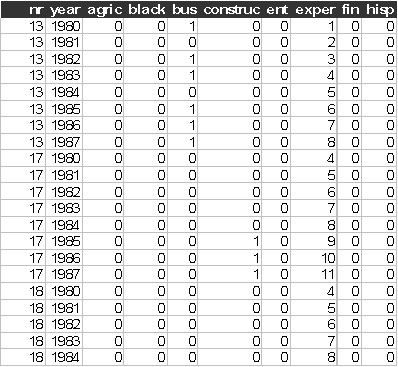Exercise L2, linear
model
Vella and Verbeek (1998) analysed the male data from the Youth Sample of the US National Longitudinal Survey for the period 1980-1987. The number of young males in the sample is 545. The version of the data set (wagepan.dat) we use was obtained from Wooldridge (2002). Here we study the determinants of wages. The same data were used by Rabe-Hesketh and Skrondal (2005, exercise 2.7).
Data description
Number of observations (rows): 4360
Number of variables (columns): 44
Description of the subset of variables we are going to use in this exercise:
nr= person identifier;
year=1980 to 1987
black=1 if respondent is black, 0 otherwise
exper=labour market experience (age-6-educ)
hisp=1 if respondent is Hispanic, 0 otherwise
poorhlth=1 if respondent has a health disability, 0 otherwise
married=1 if respondent is married, 0 otherwise
nrthcen=1 if respondent lives in the Northern Central part of the
nrtheast=1 if respondent lives in the North East part of the
rur=1 if respondent lives in a rural area, 0 otherwise
south=1 if respondent lives in the South of the
educ=years of schooling
union=1 if the respondent is a member of a trade union, 0
otherwise
lwage=log of hourly wage in US dollars
d8m=1 if the year is 198m, 0
otherwise, m=1,…,7
The first few lines and columns of the data look like (the data set contains more variables than those listed above):

Start Sabre and specify transcript file:
out wagepan.log
data nr year agric black bus construc ent exper
fin hisp poorhlth hours
&
manuf married min nrthcen nrtheast occ1 occ2 occ3
occ4 occ5 occ6 occ7 &
occ8 occ9 per
pro pub rur south educ tra trad union lwage d81 d82 d83 &
d84 d85 d86
d87 expersq
read wagepan.dat
Suggested exercises:
(1) Estimate a linear model on lwage (log of hourly wage) without covariates
(2) Allow for the person identifier (nr) random effect, use mass 64. Is this random effect significant?
(3) Add the covariates (educ, black, hisp, exper, expersq, married, union, d8m, m=1,2,…,7). How does the magnitude of the person identifier random effects change?
(4) Create interaction effects between the year indicators (d81,…,d87) and educ, add these effects to the previous model, do the returns to education vary with year? What do the results show?
References
Rabe-Hesketh, S., and Skrondal, A., (2005), Multilevel and Longitudinal Modelling using Stata, Stata Press, Stata Corp, College Station, Texas
Vella, F., and Verbeek, M., (1998), Whose wages do unions raise? A dynamic model of unionism and wage rate determination for young men. Journal of Applied Econometrics, 13, 163-183.
Wooldridge, J. M., (2002), Econometric Analysis of Cross
Section and Panel Data, MIT Press,